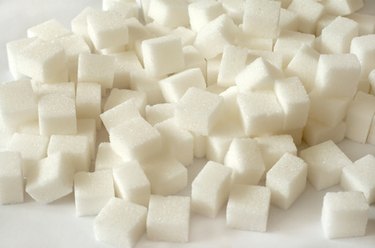
Sugar art is the practice of creating confectionery sculptures that are both decorative and edible. According to Harold McGee's book "On Food and Cooking," the art form dates back to ancient Egypt and reached elaborate heights during the medieval reign of European monarchs.
Identification
Video of the Day
Sugar art, also known as confection art, involves the creation of sculptures made entirely of sugar and sugar derivatives. Sugar art uses a combination of many different techniques of manipulating sugar including sugar lace, spun sugar, cast sugar, pulled sugar and blown sugar. Commonly created shapes are flowers, leaves, ribbons, spirals, baskets, spheres, fruit, animals, vases, birds and fish.
Video of the Day
Due to the fragile nature of hardened sugar, it is an art form known for requiring practice and patience. Today competitions that include sugar sculpture can be seen on popular television food networks.
Origins
As noted in Harold McGee's book "On Food and Cooking," the history of sugar art likely dates as far back as 4,000 B.C., when islanders in Papua New Guinea cut sugarcane for its sap. He also notes that the first candy recipe was found in an Egyptian tomb written in hieroglyphs around 3500 B.C. On the culinary horizon, sugar art has been around for centuries, evolving simultaneously in different parts of the world.
Ottoman Empire
During the early Ottoman imperial monarchy in what is now Turkey, sugar figures and elaborate gardens were commonly created for festivals and celebrations, according to an article by Dr. Metin And on the Turkish travel site adiyamanli.org. Dr. And notes that the most elaborate of these took place in 1582 to celebrate the circumcision of Mehmet III, a legendary festival lasting 51 days. Sugar figurines created for the festival included mermaids, cypress trees, fountains, peacocks, lighthouses, phoenixes, lions, leopards monkeys and churches.
European Royalty
Medieval European royalty have long been associated with some of the most elaborate sugar sculptures in history. According to a 2002 article in the London Times entitled "Let Them Eat Cake," sugar sculptures were frequently created for celebrations as not only conversation pieces but as edible diversions between courses.
The 1429 coronation feast of eight-year-old Henry VI included sugar art pieces with political themes, the London Times article noted. One recorded piece depicted a leopard grasping a fleur de lis while crouching on top of a custard tart. Henry VIII was a big fan of dried marzipan confections and allegedly had his bakers create elaborate sugar copies of his forts and cannons. In 1582, Elizabeth I was presented with a sugar model of the old St Paul's Cathedral.
In France, sugar art was at the height of its popularity in the 1600s during the reign of Louis XIV. The London Times article also reports that James II of England employed confection artists to build pyramids of sugar sculptures at his coronation banquet in 1685.
Sugar Art Today
Over time, as sugar became easily attainable, sugar art lost a lot of its novelty and prestige. Out of the ancient art of sugar sculpture however, came other beautiful, symbolic confection art forms such as specialty wedding cakes, Japanese Wagashi and Mexican Day of the Dead figures and skulls. With the advent of televised culinary shows, sugar artistry has been gaining recent popularity and exposure.